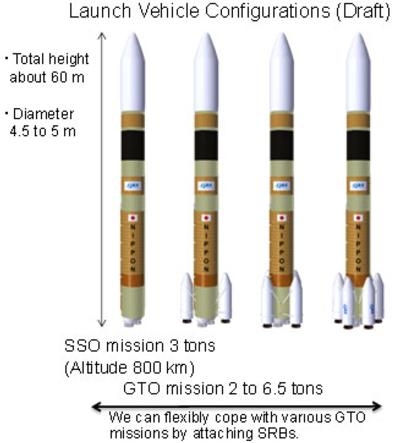First Launch Targeted For 2020
The Japan Aerospace Exploration Agency (JAXA) has selected Mitsubishi Heavy Industries, Ltd. (MHI) as the prime contractor for a newly developed flagship launch vehicle. JAXA will begin developing the new national flagship launch vehicle in early (Japan) Fiscal Year 2014 in cooperation with a group of private companies led by MHI.

The new flagship launch vehicle is intended to enter Japan into the international satellite launch market, and also enabling Japan's space transportation after the 2020s. JAXA says that will be accomplished by renovating its current flagship rockets, the H-IIA and H-IIB Launch Vehicles, and by improving usability through launch cost reduction by half and other enhancements.
The main liquid-engine core rockets will be the same specifications for all launch vehicles in the new series so that manufacturing and operation can be more efficiently performed. Up to six solid rocket boosters (depending on the needs) can be attached for a Geostationary Transfer Orbit (GTO) mission to be able to flexibly cope with diversified needs.
The development will begin in early JFY 2014 targeting a maiden launch in JFY 2020.
JAXA says utilization of space is now imperative in various areas, such as using satellite data for our daily lives, so it is important to secure the independent space transportation capability without relying on other countries to launch a satellite. Accordingly, the Japanese government also stipulates an autonomous space launch capacity as a basic space policy. The current flagship launch vehicle, H-IIA, is based on the conventional design concept of its predecessor, H-II, thus the H-IIA launch system applied many of the facilities built for the H-II. In other words, they are aging at over 30 years old since the H-II days, and they became so old that their maintenance costs are increasing year on year. In addition, no new launch vehicle development project has been conducted for about 15 years after the H-IIA development, and skilled engineers who were involved in the actual development are getting older.
If this situation is left unattended, JAXA says Japan will face difficulty maintaining its development and launch capability of launch vehicles in the future. Although the flagship launch vehicle technology is highly regarded, the agency says it needs to lower the launch costs in order to procure commercial satellite launch demand from overseas in addition to indigenous government satellites. JAXA says it has to renovate the overall launch system and develop a new flagship launch vehicle with high competitiveness for overcoming the stated challenges and making it sustainable.
The new system will employ a more sophisticated high-performance liquid hydrogen rocket engine. The planned solid rocket boosters are based on technology that has been fostered through the development of the Epsilon Launch Vehicle. JAXA says it can cope with a wide variety of launch needs by varying the number of solid rocket boosters to be attached. The basic structure of the new launch vehicle is similar to that of the H-IIA, but we will achieve two goals, low cost and high reliability, at the same time by introducing cutting-edge technologies in every area.
(Image provided by JAXA)
 ANN's Daily Aero-Linx (04.15.24)
ANN's Daily Aero-Linx (04.15.24) Classic Aero-TV: 'No Other Options' -- The Israeli Air Force's Danny Shapira
Classic Aero-TV: 'No Other Options' -- The Israeli Air Force's Danny Shapira Aero-News: Quote of the Day (04.15.24)
Aero-News: Quote of the Day (04.15.24) Airborne 04.16.24: RV Update, Affordable Flying Expo, Diamond Lil
Airborne 04.16.24: RV Update, Affordable Flying Expo, Diamond Lil ANN's Daily Aero-Term (04.16.24): Chart Supplement US
ANN's Daily Aero-Term (04.16.24): Chart Supplement US



